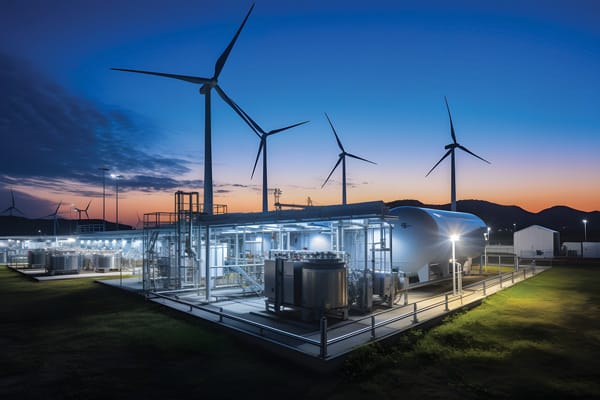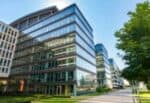By Stuart Berjansky
From the December 2023 Issue
Earth is inching ever closer to an environmental tipping point. Without major changes in the way we run our buildings and transportation systems, the planet may soon surpass the global warming threshold predicted to spark catastrophic and irreparable harm to human societies and natural ecosystems alike.
Climate change is an existential threat that demands all-hands-on-deck solutions. And lighting, which accounts for approximately 16% of total U.S. electricity consumption, clearly has a role to play. In addition to fully transitioning from legacy technologies to super-efficient LEDs, there’s currently a unique opportunity to take LEDs a step further through controlled, networked lighting that works with other building systems to maximize energy savings.

The Potential Of Networked Lighting
Envisioning a net zero future where lighting, controls, and integrated building systems enable energy savings, decarbonization, and sustainability, the DesignLights Consortium (DLC) recently commissioned a series of studies to measure the untapped potential of networked lighting as an energy saving and decarbonization solution. Some market hurdles notwithstanding, the findings are promising.
Expanding on 2020 research revealing that NLCs can boost the energy savings potential from LED lighting projects by roughly 50% (up to 70% in some building types), the DLC launched a study this year to test the economic and societal value of investing in NLCs and explore how utilities and energy efficiency (EE) programs can tailor incentives to best capture those benefits.
Occupancy sensors, a common feature of NLC systems, can save a third of the energy used for HVAC in large buildings such as retail and health facilities.
Published in August, this latest analysis found clear justification for utility and EE program investments in controlled LED lighting. The study concluded this was especially true if NLCs are integrated with HVAC systems, which comprise the most energy consuming end-use worldwide and account for over half of a typical commercial building’s energy consumption. Specifically, the study revealed that occupancy sensors, a common feature of NLC systems, can save a third of the energy used for HVAC in large buildings such as retail and health facilities.
For study models, “Economic Potential of Networked Lighting Controls in Commercial Buildings: Tapping the Added Value of HVAC Connections” relied on Arizona and Connecticut–states with robust efficiency programs but different climates. The research team then assessed potential energy savings in two situations: coupling LEDs with network controls at the time of originally planned LED installations and a “controls-ready replacement” scenario that assumes LED fixtures are designed to accommodate the future addition of NLCs. Top findings included:
- When NLCs are paired with HVAC to deliver occupancy signals, total electric energy consumption by commercial buildings drops by nearly 10% in Connecticut and 5% in Arizona, with savings of 20% possible in some buildings.
- Incentivizing and promoting NLC-HVAC integration by EE programs could save businesses $217 million in Arizona and $1.2 billion in Connecticut over six years (through 2030)–savings that would otherwise be difficult or prohibitively expensive to reach.
Despite their potential benefits, NLCs have not caught on as they should–and incentives for their adoption have lagged. One reason is the huge impact LEDs alone have had on energy efficiency in the last decade. Even as policymakers push for further expansion of LEDs, the results so far are impressive. “Historically,” reports the U.S. Energy Information Administration (EIA), “electricity use for lighting usually accounted for the largest share of total annual commercial sector electricity use, but its share has declined over time mainly because of the increasing use of high efficiency lighting equipment.” Lighting’s share of electricity consumption in commercial buildings dropped from 17% in 2012 to 9% in 2022, according to the EIA.
And, as lighting becomes more efficient, less energy is saved by each new NLC system–thus reducing the value of incentives and rebates.

(Photo: Adobe Stock / may)
LEDs Impact On Decarbonization
This scenario doesn’t auger well for efforts to maximize the energy savings and decarbonization impact of LEDs. Especially now, as first-generation LEDs are at the end of their lives and being replaced on a large scale, it’s crucial that new lighting is connected and paired with controls–or at least installed “controls-ready.” Otherwise, the longevity of LED technology means that potential savings available only through NLCs will be stranded for at least another decade. On the road to rapid decarbonization, that’s time we can’t afford to waste.
By making sure LEDs installed today either include NLCs or are equipped to include them later, commercial lighting decision makers can lock in their ability to reap the future energy savings, smart building attributes, and decarbonization benefits of advanced lighting controls.
The DLC’s 2023 NLC savings potential study identified key areas incentive programs should emphasize to spur the greatest energy savings possible through NLC-HVAC integration. From an economic as well as a sustainability perspective, there’s ample rationale for utilities and other EE programs to expand and improve NLC incentives and to eliminate incentives for uncontrolled lighting–since every lighting retrofit installed without controls is a missed opportunity to decarbonize.
While our recent research indicates the ideal efficient commercial lighting situation involves integration of connected lighting and HVAC, the key takeaway from this study and previous ones is the importance — first and foremost — of incentivizing and increasing NLC adoption to future-proof the energy savings and decarbonization value of LED lighting projects.
Case studies presented at the DLC’s Controls Summit in Detroit in September illuminated the benefits businesses can reap from incentivized networked lighting. First Federal Savings Bank in Champaign-Urbana, Illinois, for example, partnered with regional utility Ameren Illinois to install an NLC system in its 31,755 sq. ft. building. Made possible with utility incentives, the project reduced the bank’s annual electricity usage by 113,844 kilowatt hours (kWh), saving thousands of dollars and reducing greenhouse gas emissions equal to taking at least 17 cars off the road for a year.
Similarly, Detroit-based DTE Energy provided incentives worth nearly $77,800 that enabled the LaFontaine Automotive Group to complete comprehensive lighting and controls upgrades at 15 locations, saving over 1.5 million kWh of electricity and $154,000 in energy costs annually.
The Future Ahead For NLCs
Commercial lighting has transformed multiple times over the past few decades, all in pursuit of greater energy savings. That transformation continues as we learn more about the potential for controlled, networked lighting to wring even more savings from already uber-efficient LEDs. Capturing the full potential of NLCs, however, will require changing energy efficiency programs to ensure that they effectively support and prioritize NLCs over uncontrolled lighting that provides short-term benefits but effectively strands long-term savings needed to advance society’s decarbonization goals.
What’s The Biggest Barrier To Retrofitting Commercial Buildings?
ACEEE examines how conflicting interests in the commercial real estate industry prevent significant energy efficiency investment, identifies strategies for utilities to drive energy savings. Read more…
While we await these policy changes, there are steps building owners and managers can — and should —take to future-proof their lighting systems. By making sure LEDs installed today either include NLCs or are equipped to include them later, commercial lighting decision makers can lock in their ability to reap the future energy savings, smart building attributes, and decarbonization benefits of advanced lighting controls.
 With over 30 years in the lighting industry, including roles in sales, product management and solutions architecture for a major manufacturer, Berjansky provides technical direction for the DLC’s (designlights.org) mission to advance widespread adoption of high-performing commercial lighting solutions.
With over 30 years in the lighting industry, including roles in sales, product management and solutions architecture for a major manufacturer, Berjansky provides technical direction for the DLC’s (designlights.org) mission to advance widespread adoption of high-performing commercial lighting solutions.
Do you have a comment? Share your thoughts in the Comments section below, or send an e-mail to the Editor at jen@groupc.com.

















 What’s The Biggest Barrier To Retrofitting Commercial Buildings?
What’s The Biggest Barrier To Retrofitting Commercial Buildings?

![[VIDEO] Collect Asset Data at the Speed of Walking a Building](https://facilityexecutive.com/wp-content/uploads/2024/02/maxresdefault-324x160.jpg)